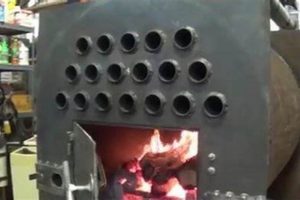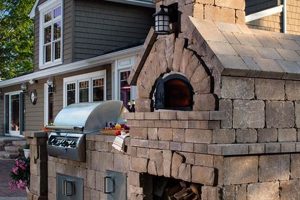Structures for outdoor heating and recreation, pre-packaged with necessary components and intended for assembly by the purchaser, represent a growing segment within the landscape improvement market. These collections typically include materials for the fire pit’s construction, such as stones, blocks, or metal components, along with instructions for their arrangement and securement. An example includes a collection of interlocking concrete blocks, adhesive, and a steel fire ring designed to create a circular outdoor fireplace on a homeowner’s patio.
The increasing popularity of these assemblies stems from their cost-effectiveness and the accessibility they provide for individuals to enhance their outdoor living spaces. They offer a controlled and contained environment for open-air fires, allowing for relaxation and entertainment. Historically, fire pits have served as central gathering points for communities, providing warmth, light, and a space for cooking and socializing; modern iterations continue this tradition in a more convenient and regulated manner.
This article will delve into the various types of these structures available, the critical factors to consider during selection and installation, and essential safety guidelines to ensure proper operation and longevity. Understanding these aspects enables informed decision-making and successful integration of these outdoor amenities into residential landscapes.
Essential Considerations for Outdoor Fireplace Projects
This section outlines critical recommendations to ensure a successful and safe experience when building an outdoor fireplace using pre-packaged materials. Adhering to these guidelines will promote both the longevity of the structure and the safety of its users.
Tip 1: Site Selection: Choose a location a safe distance from structures and flammable materials. Check local ordinances and HOA regulations regarding open burning and required setbacks. Clear the area of vegetation and debris.
Tip 2: Foundation Preparation: Create a level and stable base for the fire pit. Depending on the manufacturer’s instructions, this may involve excavating a shallow area, adding gravel for drainage, and compacting the soil. An unstable foundation can lead to structural issues over time.
Tip 3: Material Inspection: Before beginning assembly, thoroughly inspect all included components for damage or defects. Contact the supplier immediately if any pieces are missing or substandard. Using compromised materials can jeopardize the integrity of the finished structure.
Tip 4: Adherence to Instructions: Strictly follow the manufacturer’s assembly instructions. Deviating from the recommended procedure can compromise the structural integrity and safety of the finished product. Precise adherence to the directions ensures proper construction.
Tip 5: Mortar and Adhesive Application: If the structure requires mortar or adhesive, ensure proper mixing and application. Use the recommended type of mortar or adhesive as specified by the manufacturer. Incorrect mortar can lead to premature failure and instability.
Tip 6: Fire Ring Installation: Securely install the fire ring or insert according to the provided instructions. The fire ring serves as a barrier between the flames and the surrounding materials, preventing direct heat exposure and potential damage.
Tip 7: Initial Burn-In: Conduct a small, controlled burn-in after construction to allow the materials to cure and adjust. Monitor the structure closely during the initial burn to identify any potential issues. This allows for corrections before the structure is used extensively.
Tip 8: Safety Precautions: Always have a fire extinguisher or water source readily available during operation. Never leave the fire unattended, and ensure it is completely extinguished before leaving the area. Supervision is critical for safe operation.
By following these recommendations, individuals can maximize the enjoyment and safety associated with these outdoor fire features, creating a lasting and appealing addition to their landscape.
The next section will address various aesthetic considerations for integrating these features into overall landscape designs.
1. Regulations
The intersection of regulations and prefabricated outdoor fire structures represents a critical aspect of responsible landscape design and homeowner safety. Local, state, and even homeowners’ association (HOA) regulations often govern the installation and use of open-flame devices, including structures built from component collections. These regulations are implemented to mitigate fire hazards, control air quality, and minimize disturbance to neighboring properties. Failure to adhere to these regulations can result in fines, legal action, or the forced removal of the fire feature. For example, many municipalities mandate specific setbacks from structures, property lines, and flammable materials, dictating the permissible location of these outdoor amenities.
Regulations directly influence the selection and installation of these fire structures. Some areas might restrict the use of wood-burning devices altogether, favoring gas-fueled alternatives. Others might impose restrictions on the size of the fire pit, the type of fuel permitted, or the hours of operation. The impact is profound, effectively determining whether a homeowner can install a specific type of fire feature, and if so, under what conditions. Furthermore, building permits might be required, necessitating inspection and approval to ensure compliance with safety codes. A practical example is a community located in a dry climate with heightened fire risk, where strict regulations mandate the use of spark arrestors and prohibit open burning during certain months of the year.
In summary, a thorough understanding of applicable regulations is paramount before purchasing and assembling any prefabricated outdoor fire structure. Due diligence involves researching local ordinances, consulting with the local fire department, and, if applicable, reviewing HOA guidelines. Compliance ensures not only legal operation but also minimizes the risk of fire and smoke-related issues, fostering a safe and enjoyable outdoor environment for both the homeowner and the surrounding community.
2. Foundation
The foundation serves as the critical substructure upon which any prefabricated outdoor fire structure is built, influencing its stability, longevity, and overall safety. For component collections designed for owner assembly, the quality and preparation of the foundation are particularly crucial, as they directly compensate for the varying levels of expertise among installers. An inadequate foundation can lead to structural instability, causing the fire pit to tilt, shift, or even collapse over time, presenting a significant safety hazard. For example, consider a circular component collection placed directly on unlevel ground; the uneven distribution of weight can cause individual blocks to crack or separate, compromising the entire assembly.
The selection and preparation of the foundation are directly influenced by the type of fire pit structure and the soil conditions. Lightweight component collections may only require a compacted gravel base, while heavier stone or concrete structures necessitate a reinforced concrete pad. Proper drainage is also a vital consideration, preventing water accumulation that can lead to erosion and structural damage. For instance, in areas with heavy rainfall, a layer of gravel beneath the base provides essential drainage, preventing the freeze-thaw cycle from undermining the foundation and causing cracks. Ignoring proper soil compaction can also lead to settling, a common cause of uneven fire pits and structural failure. Another example lies in areas with expansive clay soils, where foundation designs require additional reinforcement to counteract soil movement.
In conclusion, the foundation is not merely a supporting element but an integral component of the system. Its proper preparation and construction are essential for ensuring the safety, stability, and longevity of the entire structure. Neglecting the foundation compromises the investment in the prefabricated fire pit and poses a significant risk. Therefore, meticulous attention to foundation preparation, incorporating appropriate materials and techniques tailored to the specific site conditions and structure type, is paramount for success.
3. Materials
The constituent components of prefabricated outdoor fire structures directly dictate their performance, durability, and aesthetic appeal. These packages, designed for owner assembly, rely on the inherent properties of their materials to withstand extreme temperatures, weather exposure, and repeated use. The selection of materials is not arbitrary; it represents a considered balance between cost, functionality, and desired aesthetic outcome. For example, a fire structure constructed from lower-grade steel may be more affordable initially but will likely exhibit accelerated corrosion and a shorter lifespan compared to one built with stainless steel or weather-resistant alloys. The composition directly impacts the structure’s ability to retain heat, resist cracking, and maintain its appearance over time. The materials determine how well the assembly retains its form and function in the face of environmental stressors. The choice of building components influences the user’s experience and satisfaction with the finished feature.
Consider concrete blocks as an alternative. The concrete mixture ratio and curing process influence structural integrity. Furthermore, the surface treatment affects resistance to staining and discoloration from smoke and ash. Refractory bricks, commonly used in the fire pit’s interior, provide superior heat resistance compared to standard bricks, preventing spalling and cracking under intense heat. The fire ring or insert, often made of steel, must withstand constant exposure to flames and high temperatures without warping or deteriorating. In addition to the primary structural components, the adhesives or mortar used for assembly play a crucial role in bonding the materials together and ensuring the overall stability of the structure. Selecting inappropriate adhesives can lead to joint failure and structural collapse.
In summary, the materials employed in prefabricated fire structures are fundamental to their success. From weather resistance to heat retention, the choice of materials dictates the structure’s longevity and safety. Understanding material properties and their suitability for fire structure applications is crucial for informed purchasing and assembly, ensuring a durable and aesthetically pleasing outdoor fire feature that delivers years of enjoyment. Compromising on material quality often leads to premature failure and diminished value, highlighting the importance of selecting structures built with robust and appropriate components.
4. Assembly
The assembly process constitutes a core element in the utilization of prefabricated outdoor fire structures. The inherent value proposition of these systems lies in their accessibility to individuals lacking specialized construction skills, making the assembly process a key determinant of user satisfaction and overall structural integrity.
- Instruction Comprehensiveness
The clarity and completeness of the provided assembly instructions directly influence the success of the project. Instructions should include detailed diagrams, step-by-step guidance, and explicit warnings regarding potential hazards. Ambiguous or incomplete instructions can lead to misinterpretations, improper construction techniques, and ultimately, a compromised structure. Examples include unclear illustrations of interlocking mechanisms or vague descriptions of adhesive application, leading to instability.
- Tool Requirements and Accessibility
The selection of tools required for assembly impacts accessibility for potential users. Kits requiring specialized tools, such as concrete saws or advanced masonry tools, may deter some individuals or necessitate professional assistance, undermining the “do-it-yourself” premise. Kits designed for simpler assembly, utilizing common household tools like levels, rubber mallets, and measuring tapes, broaden their appeal and facilitate successful construction.
- Material Handling and Ergonomics
The weight and dimensions of individual components affect the ease of handling and the ergonomic considerations during the assembly process. Heavy or awkwardly shaped components can pose physical challenges, increasing the risk of injury and potentially discouraging single-person assembly. Component design that prioritizes manageable sizes and shapes promotes safer and more efficient construction. For example, pre-cut and pre-drilled elements minimize the need for laborious cutting and fitting, improving the user experience.
- Component Interoperability and Fit
The precision with which individual components interlock and fit together is critical to the structural integrity and aesthetic appeal of the completed fire structure. Poorly manufactured components with inconsistent dimensions or imprecise interlocking mechanisms can lead to gaps, uneven surfaces, and a generally substandard finished product. Properly engineered component collections ensure tight tolerances and seamless integration, resulting in a structurally sound and visually pleasing fire feature.
In conclusion, the assembly process is integral to the overall value and appeal of prefabricated fire structures. Kits designed with clear instructions, manageable tool requirements, ergonomic component handling, and precise interoperability of components will yield higher rates of successful assembly, enhanced user satisfaction, and a durable, aesthetically pleasing outdoor fire feature. The accessibility and ease of assembly are key factors driving the popularity of these systems, making it a vital area of focus for manufacturers and consumers alike.
5. Combustion
The process of combustion forms the fundamental principle upon which wood-burning fire structures operate. Understanding the nuances of combustion within the context of pre-packaged fire structure systems is crucial for ensuring safe and efficient operation, minimizing environmental impact, and optimizing the user experience.
- Fuel Selection and Efficiency
The type and quality of wood burned directly influence the combustion process. Seasoned hardwoods, with lower moisture content, burn more efficiently and produce less smoke than green or softwood. Inefficient combustion results in incomplete burning, releasing particulate matter and volatile organic compounds into the atmosphere. Proper fuel selection minimizes smoke production and maximizes heat output within pre-fabricated fire structures.
- Airflow Dynamics and Ventilation
Adequate airflow is essential for complete combustion. Fire structures must be designed to provide sufficient oxygen to the burning wood. Restricted airflow leads to smoldering, incomplete combustion, and increased smoke production. The design of ventilation openings within the structure dictates the rate of oxygen supply and significantly impacts the efficiency and cleanliness of the burn. Proper airflow management ensures optimal combustion within these enclosed systems.
- Temperature and Burn Rate Control
Achieving and maintaining appropriate combustion temperatures is vital for efficient and clean burning. High temperatures promote complete oxidation of the fuel, minimizing the release of pollutants. The design of the fire structure, including the depth and width of the fire pit, influences the rate at which wood burns and the temperature achieved. Controlled combustion within pre-fabricated systems allows for efficient heat output and reduced emissions.
- Ash Management and Byproduct Removal
The combustion process generates ash and other byproducts that must be managed effectively. Proper ash removal is necessary to maintain airflow and prevent the accumulation of debris that can hinder combustion. The design of the fire structure should facilitate easy ash removal and disposal. Efficient ash management ensures continued optimal combustion within the system.
In summary, combustion is not merely the act of burning wood but a complex process governed by fuel selection, airflow dynamics, temperature control, and byproduct management. Within the context of prefabricated systems, a thorough understanding of these factors is essential for safe, efficient, and environmentally responsible operation. Optimal combustion yields maximum heat output and minimized smoke emission, enhancing the user experience and mitigating environmental impact.
6. Aesthetics
Aesthetic considerations play a pivotal role in the selection and integration of pre-packaged outdoor fire structures within residential landscapes. The visual harmony between the fire feature and its surroundings significantly contributes to the overall ambiance and perceived value of the outdoor living space.
- Material Palette and Texture
The selection of materials and their inherent textures exert a profound influence on the visual impact of the fire feature. The material should complement the architectural style of the home and the existing landscape elements. For example, a fire pit constructed from natural stone might integrate seamlessly with a rustic garden setting, while a sleek, modern design utilizing polished concrete or metal could better suit a contemporary patio. The texture of the materials, whether rough-hewn stone or smooth, refined metal, contributes to the tactile and visual appeal of the structure.
- Form and Proportion
The shape and size of the fire structure must be carefully considered in relation to the surrounding space. A large, imposing fire pit might overwhelm a small patio, while a diminutive structure could be lost in a sprawling backyard. The proportion of the fire feature should be visually balanced with the scale of the landscape. Circular or square designs offer geometric symmetry, while asymmetrical forms can introduce a more dynamic and contemporary aesthetic.
- Color Harmony and Contrast
The color palette of the fire feature should harmonize with or provide a complementary contrast to the existing landscape elements. Neutral tones, such as grays, browns, and beiges, tend to blend seamlessly with natural surroundings. Bold colors can be used to create a focal point and add visual interest. Color contrast can be employed to highlight the fire pit’s form and texture.
- Integration with Landscape Lighting
The strategic placement of landscape lighting can enhance the aesthetic appeal of the fire structure, particularly during evening hours. Uplighting can accentuate the texture and form of the fire pit, while downlighting can provide ambient illumination for the surrounding seating area. The interplay of light and shadow can create a dramatic and inviting atmosphere. Low-voltage LED lighting offers energy efficiency and design flexibility.
The careful consideration of these aesthetic elements transforms a functional fire structure into a visually compelling landscape feature. The harmony between the fire pit and its surroundings contributes to the overall aesthetic coherence and enhances the enjoyment of the outdoor living space. The success of integrating these pre-packaged systems lies not only in their functionality but also in their ability to elevate the visual appeal of the landscape.
Frequently Asked Questions Regarding Wood Burning Fire Pit Kits DIY
The following addresses common inquiries concerning the selection, installation, and safe operation of wood burning fire pit kits designed for do-it-yourself assembly.
Question 1: Are permits generally required for the installation of a wood-burning fire pit structure constructed from a pre-packaged collection?
Local municipalities frequently mandate permits for structures involving open flames. Contacting the local building or fire department is crucial to ascertain specific requirements before commencing any construction activity. Ignoring permit obligations can result in fines or forced removal of the fire pit.
Question 2: What constitutes a safe distance from structures and flammable materials when positioning a wood burning fire pit component collection?
Minimum setback distances vary depending on local ordinances and the fire pit’s size and design. A general guideline is to maintain a distance of at least 10 feet from any structure, overhang, or combustible material. Consult local fire safety codes for specific requirements.
Question 3: What type of foundation is typically recommended for supporting a wood-burning fire structure made from pre-cut materials?
The appropriate foundation depends on the size and weight of the structure. Smaller, lighter structures may require only a compacted gravel base, while larger, heavier structures typically necessitate a reinforced concrete pad. Manufacturer instructions should be consulted for specific recommendations tailored to the system.
Question 4: Is professional assistance necessary for assembling a wood burning fire structure from a comprehensive kit?
While these collections are designed for do-it-yourself assembly, individuals lacking construction experience or possessing limited physical capabilities may benefit from professional assistance. Complex designs or heavy components may necessitate specialized skills and equipment.
Question 5: What type of fuel is appropriate for wood-burning fire pit systems?
Seasoned hardwoods, such as oak, maple, or ash, are generally recommended. These woods burn cleaner and produce less smoke than softwoods. Avoid using chemically treated wood, painted wood, or other materials that release harmful toxins when burned.
Question 6: What safety precautions are essential when operating a wood burning fire structure assembled from a kit?
Never leave a fire unattended. Keep a fire extinguisher or water source readily available. Ensure the fire is completely extinguished before leaving the area. Supervise children and pets closely around the fire pit. Avoid burning during windy conditions.
Adherence to these recommendations enhances both the safety and the long-term viability of these outdoor features. These pre-fabricated structures offer great out door relaxation when assembled correctly.
The next section provides information on the best kits to buy.
Wood Burning Fire Pit Kits DIY
The preceding sections have illuminated the multifaceted considerations inherent in the selection, assembly, and responsible utilization of pre-packaged wood-burning fire features. This exploration has underscored the significance of regulatory compliance, foundation integrity, material suitability, precise assembly techniques, controlled combustion practices, and aesthetic integration. Successfully navigating these elements translates to the creation of a safe, functional, and visually appealing outdoor amenity.
Informed decision-making, grounded in a thorough understanding of the technical and practical aspects discussed, is paramount. The long-term value and enjoyment derived from these features depend on careful planning, diligent execution, and unwavering adherence to safety protocols. Continued advancements in materials and design promise further refinements in the accessibility and sustainability of wood burning fire pit kits diy, solidifying their place as integral components of contemporary outdoor living spaces.







